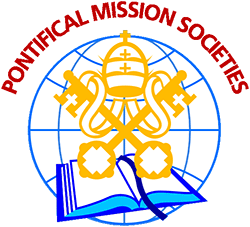Saint Kateri Tekakwitha
First Native American Saint and “Model” Missionary
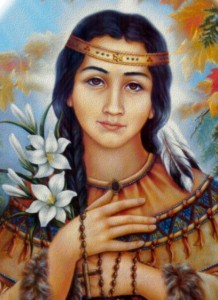
Kateri was born in 1656 of an Algonquin mother and a Mohawk Chief in the Mohawk village of Ossernenon [modern day Auriesville] in upstate New York. When she was only 4 years old her parents and brother died of smallpox. Kateri survived the disease, but it left her face badly scarred and her eyesight impaired. Because of her poor vision, Kateri was named “Tekakwitha”, which means “she who bumps into things”. Kateri was taken in by her uncle who was bitterly opposed to Christianity. When she was 8 years old, Kateri’s foster family, in accordance with Iroquois custom, paired her with a young boy who they expected she would marry. However, Kateri wanted to dedicate her life to God by remaining single and offering her life to Jesus.
She had fallen in love with Jesus and decided to remain a virgin. Virginity was unheard of amongst the Indians and they pressured her to marry and to work on Sunday, but she refused to do so. When they connived to have her lodge visited by a young warrior in the hopes of their union, she turned him out. Then the Indians treated her as a slave and put her to work for the village.
When Kateri was 18 years of age, she began instructions in the Catholic Faith in secret. Her uncle finally relented and gave his consent for Kateri to become a Christian, provided that she did not try to leave the Indian village. For joining the Catholic Church, Kateri was ridiculed and scorned by villagers. She was subjected to unfair accusations and her life was threatened.
Nearly two years after her baptism, she escaped to the Mission of St. Francis Xavier, who is the patron saint of Missionaries, in Canada. During her time in Canada, Kateri taught prayers to children and worked with the elderly and sick. She would often go to Mass both at dawn and sunset. She was known for her great were filled with great suffering from a serious illness. She died on April 17th, 1680. Tradition holds that Kateri’s final words were . . .“Jesus, I love you”, after which she embraced her creator for all eternity.
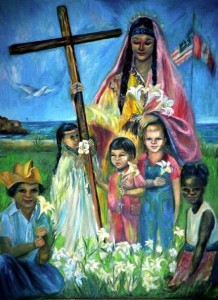
Witnesses reported that within a few minutes of her death, the pockmarks from smallpox completely vanished and her face shone with radiant loveliness.
Before her death, Kateri promised her friends that she would continue to love and pray for them in heaven. Both Native Americans and settlers immediately began praying for her heavenly intercession. Several people, including a priest who attended Kateri during her last illness, reported that Kateri had appeared to them and many healing miracles were attributed to her.
St. Kateri Tekakwitha’s Feast Day is July 14. Because of her purity, she is known as the “Lily of the Mohawks.” Pope Benedict XVI canonized Kateri on World Mission Sunday, October 21, 2012. He called St. Kateri the “protectress of Canada and the first Native American saint” and he entrusted to her “the renewal of the faith in the First Nations and in all of North America.”
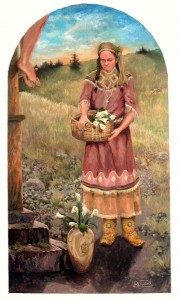
Archbishop of Philadelphia, Charles J. Chaput, who is of American Indian descent, said, “I think many young people today are embarrassed about embracing the Catholic faith because they live in a secular culture that’s hostile toward religious experience. St. Kateri also grew up in a place where there was great hostility toward Christianity, but she resisted all efforts to turn her away from her faith, so in some ways, she would be a model of fidelity in the face of persecution on religious freedom grounds.”
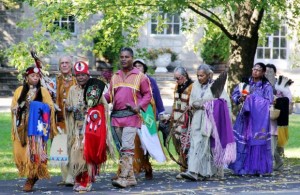
Suggested Missionary Activity:
Let us ask St. Kateri Tekakwitha to guard and guide those who are not yet followers of Christ. We can pray that they open their hearts to the great gift of faith.
